Database Access in VB.net
Applications talk to a database in two ways: first, to get the data stored there and show it in a way that’s easy to understand, and second, to update the database by adding, Updating, or removing data.
Microsoft ActiveX Data Objects.Net (ADO.Net) is a model that is part of the .Net framework.
It is used by .Net applications to get, access, and change data.
Data Provider
A data provider is used to connect to a database, run commands, retrieve data, store it in a dataset, read the data that was retrieved, and update the database.
The following four things make up the ADO.Net data provider:
| # | Objects | Description |
|---|---|---|
| 1. | Connection | This component is used to set up a connection with a data source. |
| 2. | Command | A command is a SQL statement or a stored procedure used to retrieve, insert, delete or modify data in a data source. |
| 3. | DataReader | Data reader is used to retrieve data from a data source in a read-only and forward-only mode. |
| 4. | DataAdapter | This is integral to the working of ADO.Net since data is transferred to and from a database through a data adapter. It retrieves data from a database into a dataset and updates the database. When changes are made to the dataset, the changes in the database are actually done by the data adapter. |
How to Connect Access Database in VB.net
Let’s begin:
Time needed: 20 minutes
Steps How to Connect Access Database in VB.Net
- Step 1: Create an MS Access Database.
Open an MS Access Database on your Computer and Create a Blank Database and Save it as “inventorydb.accdb”.
- Step 2: Create a Database Table.
To create a table, follow the image below and save it as “tblitems”.

- Step 3: Populate the table.
Add sample records in the table. follow the sample records in the image below.

- Step 4: Create a VB.Net Application.
Open Visual Studio and Create a Visual Basic Application project and Save it as “connectvbaccess”.
- Step 5: Design the user interface.
To design the form, you need to follow the image below.

- Step 6: Add New Data Source.
On the menu, click data and select “Add new Data Source..”

- Step 7: Choose a Data Source Type
Select Database and click Next.

- Step 7: Choose a Data Source
Click new Connection then, Select the Microsoft AccessDatabase file and, Click Continue. Follow the image below.

- Step 9: Add Connection
First, click the Browse Button then, Select “inventorydb.accdb”, Lastly, Click Open.

- Step 10: Test Connection
To test the connection, click the “Test Connection” button, and finally, click the “OK” button at the side of the “Cancel” button.

- Step 11: Copy the Connection String.
Copy the connection string so that we can use this in our next step.

- Step 12: Start Coding.
In this final step, we will start adding functionality to our vb.net program by adding some functional codes.
Code To Connect Access Database in VB.Net
Double the “Form1” and add the following code under “Public Class Form1”.
Dim con As New OleDb.OleDbConnection("Provider=Microsoft.ACE.OLEDB.12.0;Data Source=C:\Users\joken\Documents\inventorydb.accdb")
The Code above started with a Declaration of Variable name “con” with an Ole Object Type OledbConnection.
Inside OledbConnection, we pasted the connection string we copied from the “Step 11” instructions.
Test the Connection of Access database in VB.Net
To test the connection between the MS access database and VB.Net, Double click form1 and add the following code under “Form1_Load” events.
Try
con.Open()
If con.State = ConnectionState.Open Then
MsgBox("Connected")
Else
MsgBox("Not Connected!")
End If
Catch ex As Exception
MsgBox(ex.Message)
Finally
con.Close()
End Try- We use try-catch to the exceptions that may occur during runtime.
- open the connection
- check using if statement if the connection is open
- ‘Display a message box if successfully connected or Not
- close the connection
Press “F5” to run the Project.
When you run the project it will give you this message.

How to Load Record from Access Database to Datagridview In VB.Net
In this section, we will learn how to load a record from the Access database to Datagridview using vb.net. To start with, double-click the “Load record” button and add the following code.
Try
Dim sql As String
Dim cmd As New OleDb.OleDbCommand
Dim dt As New DataTable
Dim da As New OleDb.OleDbDataAdapter
con.Open()
sql = "Select * from tblitems"
cmd.Connection = con
cmd.CommandText = sql
da.SelectCommand = cmd
da.Fill(dt)
DataGridView1.DataSource = dt
Catch ex As Exception
MsgBox(ex.Message)
Finally
con.Close()
End TryAfter adding the code, you may press F5 or click the Start debugging button to test the code. The output should look like as shown below.
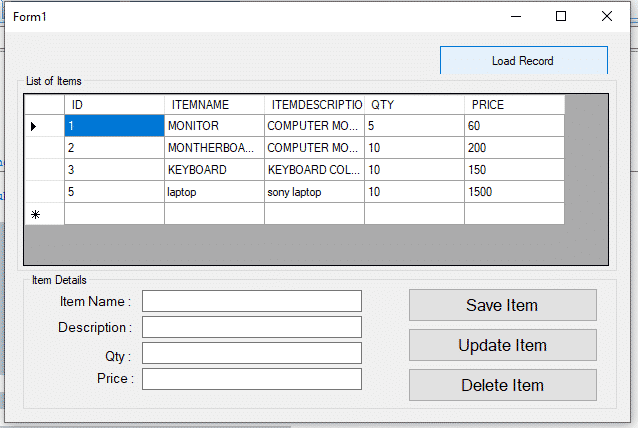
Save Record in Access Database using VB.net
In this section, we learn how to save the record in the access database using vb.net. To do this, double-click the “Save Item” button and add the following code.
Try
Dim sql As String
Dim cmd As New OleDb.OleDbCommand
con.Open()
sql = "INSERT INTO tblitems (ITEMNAME,ITEMDESCRIPTION,QTY,PRICE) values ('" & txtitemname.Text & "', '" & txtdescription.Text & "'," & Val(txtqty.Text) & "," & Val(txtprice.Text) & ");"
cmd.Connection = con
cmd.CommandText = sql
i = cmd.ExecuteNonQuery
If i > 0 Then
MsgBox("New record has been inserted successfully!")
Else
MsgBox("No record has been inserted successfully!")
End If
Catch ex As Exception
MsgBox(ex.Message)
Finally
con.Close()
End TryCode explanation:
- We start the code by adding a try-catch.
- declare variable “sql” as a string this will hold the INSERT STATEMENT.
- Declare variable “cmd” as oledbCommand it represents an SQL Statement or Store procedure to execute against a data source.
- next, we open the connection.
- Then, we assign a query command to the “sql” variable.
- Execute the Command.
- Then we assign the result of “ExecuteNonQuery” to the “i” variable.
- Next, we check if the value of the variable “i” is greater than 0.
- we use the if condition statement if the result is true then will display a message box “New record has been inserted successfully!”.
- else if the result is false, the display is “No record has been inserted successfully!”
At this time, you can now press “F5” to test the code.
Updating of Records from Access Database In VB.Net
In this section, we will learn how to update records from an access database using vb.net. In order for us to proceed in updating the record, we will add first a code to pass value from datagridview to textboxes.
To start with, go back to form design and double-click the datagridview. And Change the Event to “CellClick” from “CellContentClick”.
It means that every time the user clicks the selected data in the Datagrid view, the value will automatically pass to the text boxes.
So here’s the following code.
Me.Text = DataGridView1.CurrentRow.Cells(0).Value
txtitemname.Text = DataGridView1.CurrentRow.Cells(1).Value
txtdescription.Text = DataGridView1.CurrentRow.Cells(2).Value
txtqty.Text = DataGridView1.CurrentRow.Cells(3).Value
txtprice.Text = DataGridView1.CurrentRow.Cells(4).ValueAnd here’s the Following code for Updating the record from the access database using vb.net.
Try
Dim sql As String
Dim cmd As New OleDb.OleDbCommand
con.Open()
sql = "UPDATE tblitems SET ITEMNAME='" & txtitemname.Text & "', ITEMDESCRIPTION='" & txtdescription.Text & "', " & _
" QTY=" & Val(txtqty.Text) & ", PRICE=" & Val(txtprice.Text) & " WHERE ID=" & Val(Me.Text) & ""
cmd.Connection = con
cmd.CommandText = sql
i = cmd.ExecuteNonQuery
If i > 0 Then
MsgBox("Record has been UPDATED successfully!")
Else
MsgBox("No record has been UPDATED!")
End If
Catch ex As Exception
MsgBox(ex.Message)
Finally
con.Close()
End TryThe code we use for updating the record from the ms access database using vb.net is almost similar to the code above for inserting a new record to the ms access database in vb.net.
Only the Query is different.
Deleting of Records from Access Database In VB.Net
For deleting records from the access database in vb.net, we will still use the same code in inserting and updating the record from access using vb.net.
Go back to Form design and double-click the “Delete Item” button. Then add the following code.
Try
Dim sql As String
Dim cmd As New OleDb.OleDbCommand
con.Open()
sql = "Delete * from tblitems WHERE ID=" & Val(Me.Text) & ""
cmd.Connection = con
cmd.CommandText = sql
i = cmd.ExecuteNonQuery
If i > 0 Then
MsgBox("Record has been deleted successfully!")
Else
MsgBox("No record has been deleted!")
End If
Catch ex As Exception
MsgBox(ex.Message)
Finally
con.Close()
End TryAfter this process, you can now run the program to test if all the codes in this tutorial are working well.
Bonus Tips
Watch the full video tutorial about How to Connect to an Access Database in VB.NET until the end to see the bonus techniques and apply them to your project.
After you complete this tutorial, you can proceed on how to master VB.Net and MySQL Database in 30 minutes.
Download the vb.net project full Source code Below.
Summary
In summary, we have discussed how to connect the access database in vb.net. Then we add code for loading of records from the access database to datagridview using vb.net.
We learned also how to insert, update, and delete records from the access database using vb.net.
Frequently Asked Questions
The data provider is used to connect to a database. Executing commands and retrieving data, storing it in a Dataset, reading the retrieved data, and updating the database.
This component is used to set up a connection with a data source
A command is a SQL statement or a stored procedure used to retrieve, insert, delete or modify data in a data source.
This is integral to the working of ADO.Net since data is transferred to and from a database through a data adapter. It retrieves data from a database into a dataset and updates the database. When changes are made to the dataset, the changes in the database are actually done by the data adapter.
The dataset is an in-memory representation of data. It is a disconnected, cached set of records that are retrieved from a database. When a connection is established with the database, the data adapter creates a dataset and stores data in it.
Datatable consists of the DataRow and DataColumn objects. The DataTable objects are case-sensitive.
OleDbConnection is designed for connecting to a wide range of databases, like Microsoft Access and Oracle.
SqlConnection is designed for connecting to Microsoft SQL Server.
If you have any questions or suggestions about how to connect to access the database in vb.net, please leave a comment below.
Other Articles Readers might read:
- How to Load Data From MySQL Database to Table Element Using Java
- How to Use a Module in AutoSuggest and AutoAppend in VB.Net and MySQL Database
PREVIOUS
NEXT


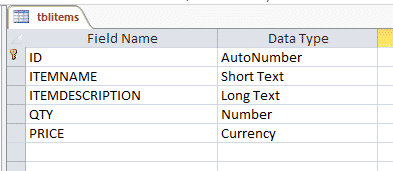

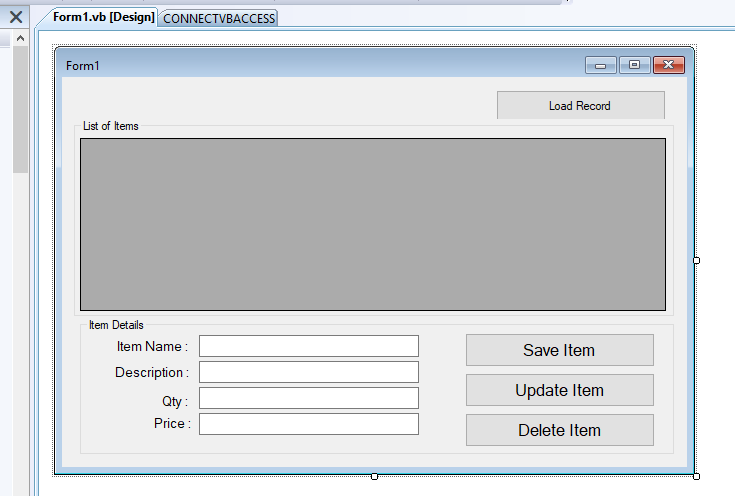
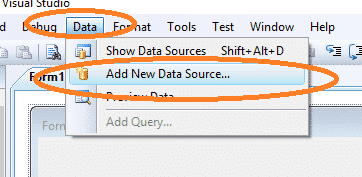
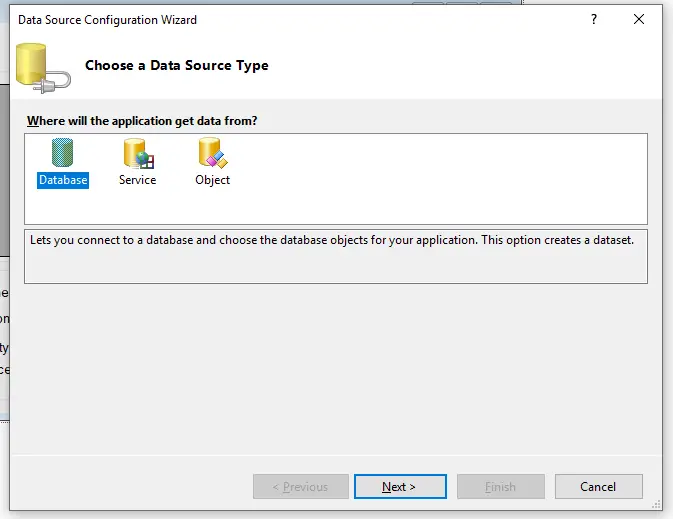
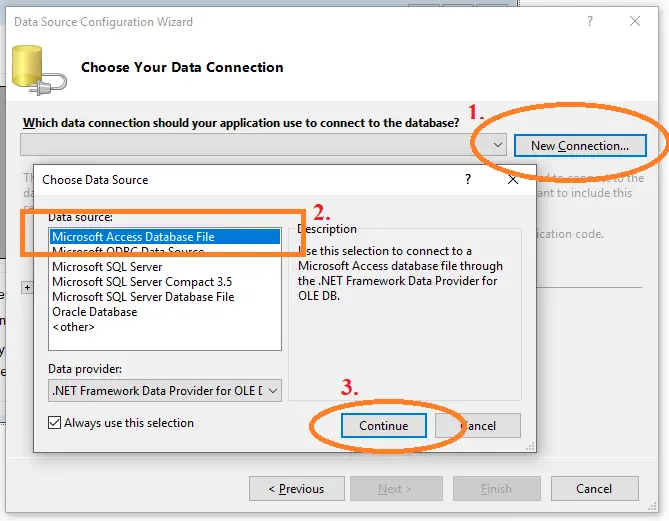

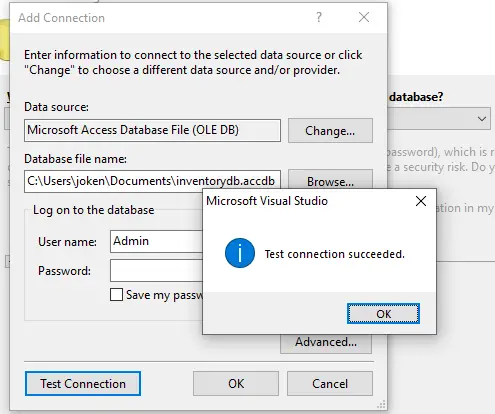



thank you very much
zoom class?
wHAT IS & txtitemname.Text & .. YOU DIDNT DECLARED AMP.
Ali:-
yes he didn’t, but you will find the answer in the following of his youtubes
https://www.youtube.com/watch?v=d19592oQjdw
and I am very thankful to him
Thank you very much 👍
You know i did the exact thing, so when i run my project it displays this message “conversion from string Connected to type integer is not valid”
Please help